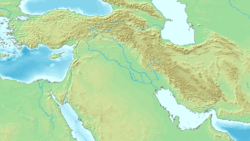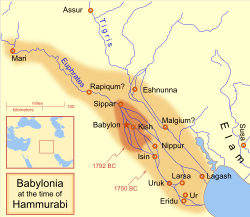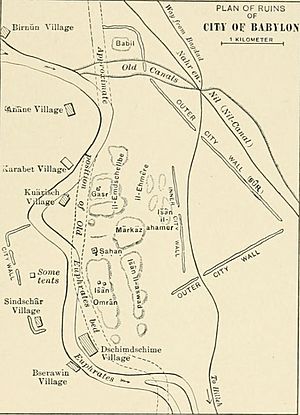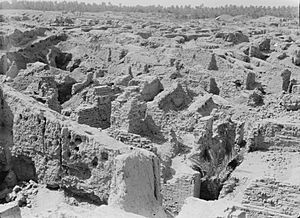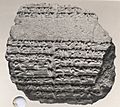Babylon facts for kids
|
Bābilim
|
|
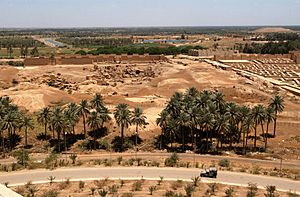
A partial view of the ruins of Babylon from Saddam Hussein's Summer Palace
|
|
| Location | Hillah, Babil, Iraq |
|---|---|
| Region | Mesopotamia |
| Coordinates | 32°32′11″N 44°25′15″E / 32.53639°N 44.42083°E |
| Type | Settlement |
| Part of | Babylonia |
| Area | 9 km2 (3.5 sq mi) |
| History | |
| Founded | c. 1894 BC |
| Abandoned | c. AD 1000 |
| Cultures | Akkadian, Amorite, Kassite, Assyrian, Chaldean, Achaemenid, Hellenistic, Parthian, Sasanian |
| Site notes | |
| Archaeologists | Hormuzd Rassam, Robert Koldewey |
| Condition | Ruined |
| Ownership | Public |
| Official name: Babylon | |
| Criteria: | Cultural: (iii), (vi) |
| Designated: | 2019 (43rd session) |
| Reference #: | 278 |
| State Party: | |
| Region: | Arab States |
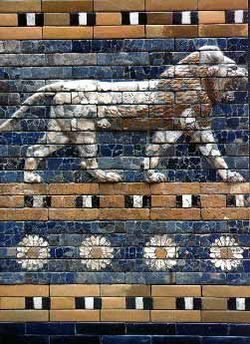
Babylon was an important ancient city-state in Mesopotamia, which is now modern-day Iraq. It was located about 85 kilometers (55 miles) south of Baghdad. Today, all that remains of this once-great city are mounds of broken mud-brick buildings and rubble. These ruins are found in the fertile plain between the Tigris and Euphrates rivers.
Babylon began as a small town around 3000 BCE. Over time, it grew and became very famous and powerful. It even became more important than Nippur, which was once considered the 'holy city' of Mesopotamia. Babylon became the capital of the Neo-Babylonian Empire after Hammurabi united the Babylonian Empire. This was between 612 and 539 BCE.
One of the most famous parts of Babylon was the Hanging Gardens of Babylon. These gardens were known as one of the Seven Wonders of the Ancient World.
Contents
About Ancient Babylon
Babylon was a very advanced city for its time.
Life and Learning in Babylon
- In Babylon, both boys and girls could go to school.
- Hammurabi built many schools and libraries.
- Unlike other ancient societies, women in Babylon had many rights.
- They could become priests or start their own businesses.
- Women also had equal rights to property with their husbands.
- The main god of the Babylonians was Marduk.
- They also worshipped gods and goddesses from the Sumerian culture.
Famous Laws and Stories
- The Code of Hammurabi is one of the earliest sets of laws ever written.
- These laws were carved onto a stone tablet.
- They helped guide the people of Babylonia in their daily lives.
- A well-known story about Babylon from the Bible is the Tower of Babel.
Where Was Babylon?
The remains of Babylon are in Hillah, Babil Governorate, Iraq. It's about 85 kilometers (55 miles) south of Baghdad. The site is a large mound of broken mud-brick buildings. It covers an area of about 2 by 1 kilometer (1.2 by 0.6 miles). The ruins stretch from north to south along the Euphrates River.
The river used to flow through the middle of the city. But the river has changed its path over time. Now, most of the western part of the city is underwater. Some parts of the city wall on the west side of the river can still be seen.
Important parts of the city's ruins include:
- Kasr: Also called the Palace or Castle. This is where the Neo-Babylonian ziggurat Etemenanki was located. It's in the center of the site.
- Amran Ibn Ali: This is the tallest mound, about 25 meters (82 feet) high, located to the south. It was the site of Esagila. This was a temple dedicated to Marduk, the main god. It also had shrines for Ea and Nabu.
- Homera: A reddish mound on the west side. Most of the Hellenistic remains are found here.
- Babil: A mound about 22 meters (72 feet) high at the northern end. Its bricks have been taken by people since ancient times. This mound held a palace built by King Nebuchadnezzar.
Other ancient cities nearby include Kish, Borsippa, Dilbat, and Kutha. Marad and Sippar were about 60 kilometers (37 miles) away along the Euphrates.
Babylon's History with Empires
The Assyrian Period
During the rule of Sennacherib of Assyria, Babylonia was often rebelling. To stop these revolts, Sennacherib completely destroyed the city of Babylon in 689 BCE. Its walls, temples, and palaces were torn down. The rubble was thrown into the Arakhtu River. This act shocked many people in Mesopotamia.
After Sennacherib's death, his successor Esarhaddon quickly rebuilt the old city. He was crowned there and lived there for part of the year. Later, when the Assyrian Empire fell, many Babylonians saw it as a sign of divine justice.
The Neo-Babylonian Empire
Babylon gained its freedom from Assyrian rule in 612 BCE. It then became the capital of the new Neo-Babylonian Empire. This was also known as the Chaldean Empire.
With its independence, Babylon entered a new era of construction. King Nebuchadnezzar II (604–561 BCE) transformed Babylon into one of the most amazing cities of the ancient world. He ordered the complete rebuilding of the royal areas. This included rebuilding the Etemenanki ziggurat (a large stepped tower). He also built the famous Ishtar Gate. This was the most impressive of the eight gates that surrounded Babylon. Only the foundations and scattered bricks of the original Ishtar Gate have been found.
Nebuchadnezzar is also believed to have built the Hanging Gardens of Babylon. These were one of the seven wonders of the ancient world. It is said he built them for his wife, Amyitis, who missed her homeland. However, historians still debate if these gardens truly existed in Babylon. Some think they might have been confused with gardens in Nineveh.
Persia Takes Over Babylon
In 539 BCE, the Neo-Babylonian Empire was conquered by Cyrus the Great. He was the king of Persia. This happened during the Battle of Opis. The walls of Babylon were very tall and thick. The only way into the city was through its many gates. The Euphrates River flowed next to the walls. Cyrus decided to use the river to enter the city.
Cyrus's troops changed the river's path. This made the water level drop, allowing soldiers to walk into the city. The Babylonians were having a celebration that evening. The Persian Army took over most of the city before the Babylonians even realized what was happening. This story was told by the historian Herodotus. It is also mentioned in the Hebrew Bible. Cyrus entered the city with little to no resistance from the celebrating Babylonians.
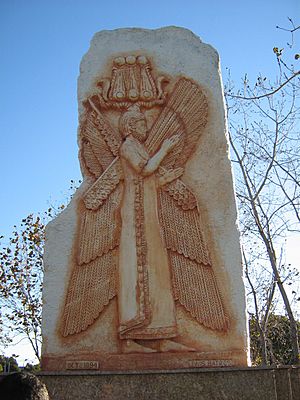
Cyrus later issued a special order. It allowed people, including the Jews, to return to their own lands. This is mentioned in the Old Testament. It also allowed the Jewish temple to be rebuilt in Jerusalem.
Under Cyrus and the next Persian king, Darius the Great, Babylon became the capital of a large province. It was a center for learning and science. In Achaemenid Persia, Babylonian astronomy and mathematics became very important again. Babylonian scholars even made maps of star groups. Babylon was the administrative capital of the powerful Persian Empire. Many important discoveries have been made that help us understand this time.
Early Persian kings tried to respect the religious ceremonies of Marduk. But by the time of Darius III, heavy taxes and many wars weakened Babylon. Its main shrines and canals fell apart. Despite three rebellions, Babylon remained under Persian rule for two centuries. In 331 BCE, Alexander the Great conquered the city. Under the Parthian Empire, Babylon continued to shrink and lose its importance.
Babylon's Cultural Impact
Before modern discoveries, people in the West didn't really know what Babylon looked like. Artists often imagined it as a mix of ancient Egyptian, Greek, and Ottoman styles.
Because of its long history and mentions in the Bible, the word "Babylon" now often means a big, busy, and diverse city. Here are some examples:
- In reggae music, "Babylon" is used in the Rastafari belief system. It refers to the materialistic, capitalist world.
- Freemasonry sees Babylon as a birthplace of science and knowledge.
- Babylon 5 is a science fiction TV series. It's about a futuristic space station with many different alien races.
- Babylon A.D. is a movie set in New York City in the future.
- Babilonas is the Lithuanian name for "Babylon." It's also the name of a real estate development in Lithuania.
Babylon in the Bible
In the Bible's Genesis 10:10, Babel (Babylon) is described as being founded by Nimrod. Other cities like Uruk, Akkad, and possibly Calneh were also founded by him in the land of Shinar. Another story in Genesis 11 tells of all humanity speaking one language. They moved to Shinar to build a city and a tower.
Babylon appears throughout the Hebrew Bible. This includes stories about the Babylonian Captivity, when many Jews were taken to Babylon. It also appears in several prophecies. The New Testament Book of Revelation mentions Babylon many centuries after it was a major city. Some scholars believe this refers to the Roman Empire in a symbolic way.
Related pages
Images for kids
-
Sennacherib of Assyria during his Babylonian war, relief from his palace in Nineveh
-
Cuneiform cylinder from reign of Nebuchadnezzar II honoring the exorcism and reconstruction of the ziggurat Etemenanki by Nabopolassar.
-
A reconstruction of the blue-tiled Ishtar Gate, which was the northern entrance to Babylon. It was named for the goddess of love and war. Bulls and dragons, symbols of the god Marduk, decorated the gate.
-
Babylonian soldier in the Achaemenid army, circa 470 BCE, Xerxes I tomb.
See also
 In Spanish: Babilonia (ciudad) para niños
In Spanish: Babilonia (ciudad) para niños


